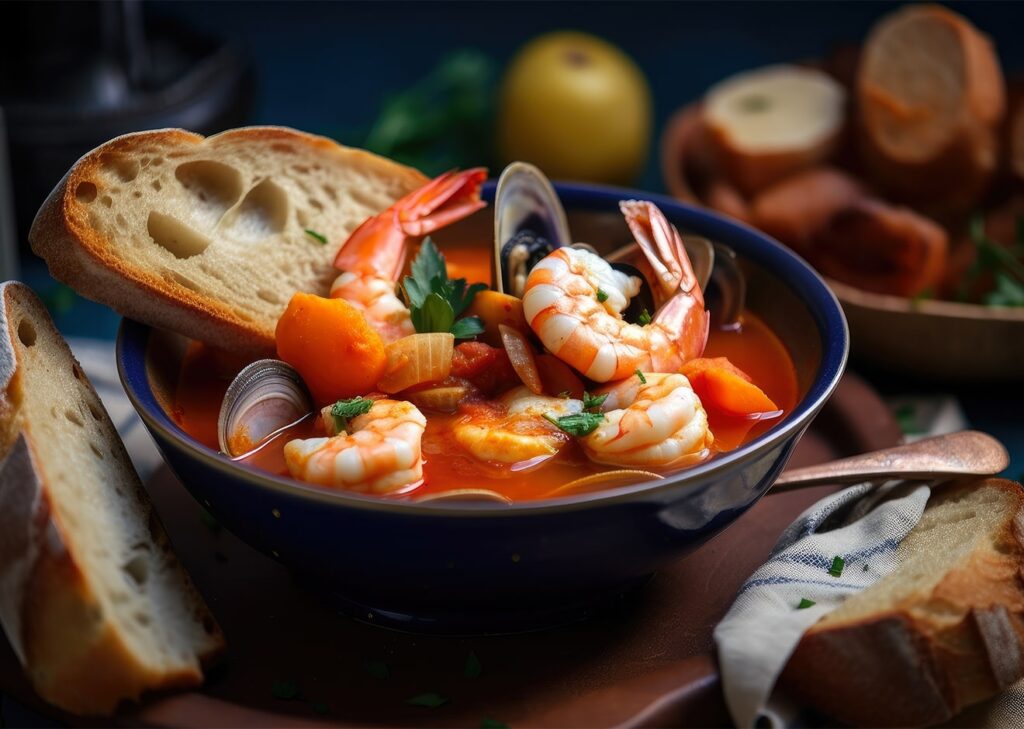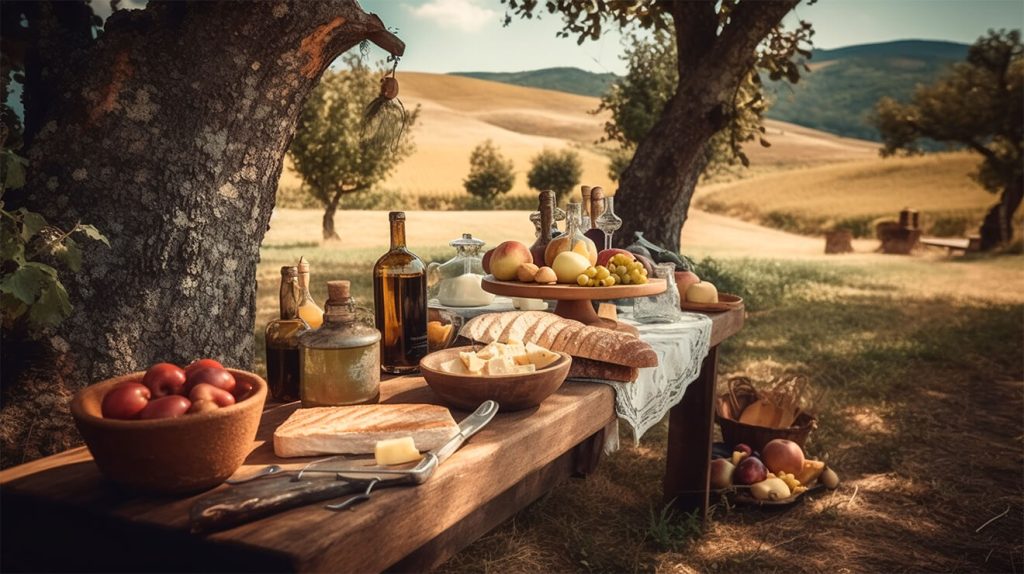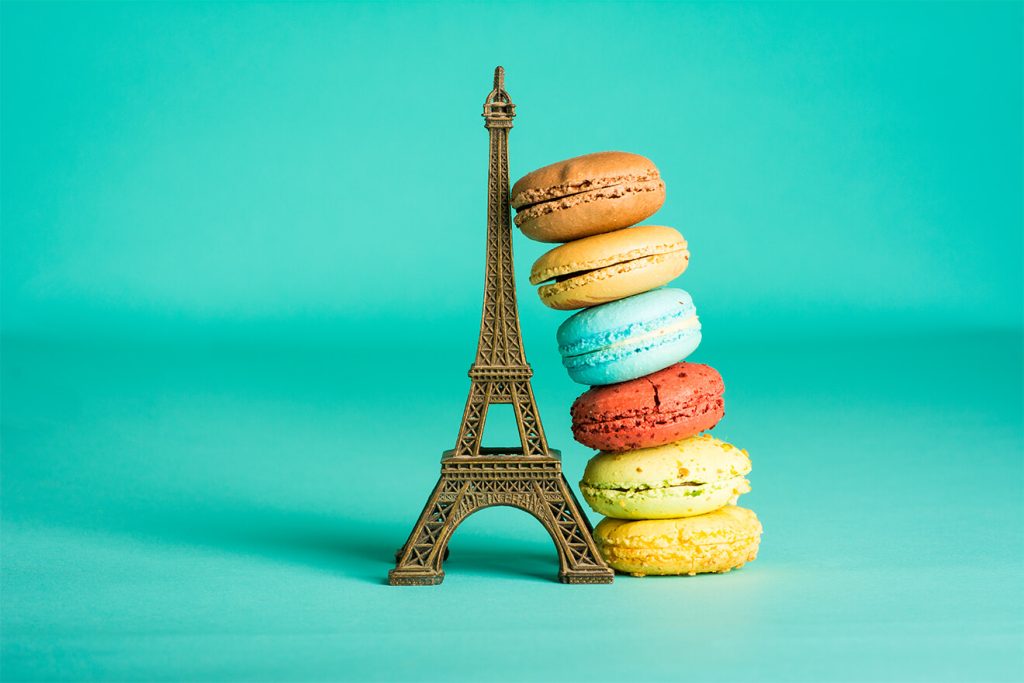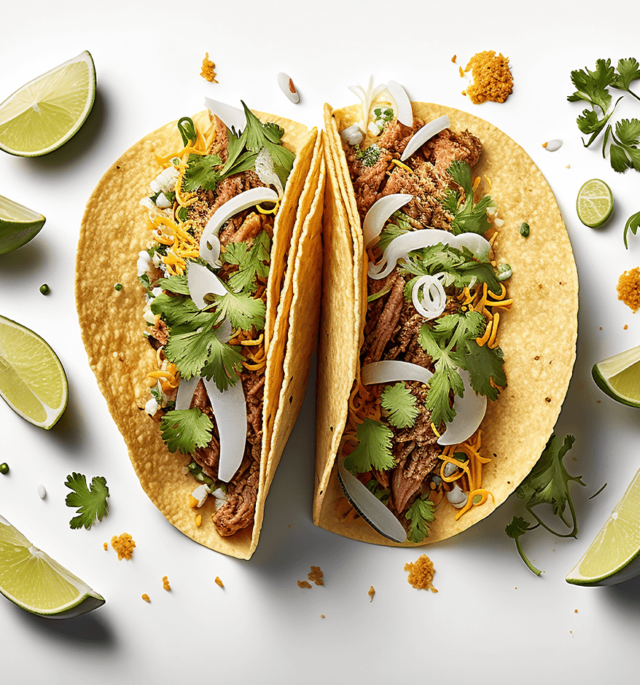
Table of Contents
French cuisine, often hailed as the epitome of gastronomy, showcases the best French food. Have you ever experienced the authentic essence of French cuisine, in which every dish is a creative nod to illustrious culinary past?
French food is known for its sophisticated intricacy and iconic dishes that appeal to foodies all over the world. Each bite of French cuisine offers a taste of refinement and cultural heritage.
Savor the Starter: French Appetizers
The exquisite selection of hors d’oeuvres is the first course on the culinary voyage of French cuisine. Imagine the sophistication of chilly oysters à la mignonnette, the rustic beauty of tartine with its hearty base of country bread, and the decadent attraction of foie gras accompanied by a tart and sweet sauce—a taste of the many delectable culinary delights to come.
With a hint of what’s to come, each beginning is a symphony of flavors, expertly balanced to pique the appetite. Sophisticated simplicity of a well-made niçoise salad and delicate escargots à la bourguignonne, dipped in herbed butter, entice diners to discover the frontiers of French culinary refinement. Amidst this culinary journey, one cannot overlook the allure of the best French food, with its fusion of tradition and innovation, from the delicate intricacies of coq au vin to the indulgent richness of boeuf bourguignon.
Crusty Baguette with Rich Pâté
Starting a traditional French meal would mean tasting the traditional pairing of a well cooked baguette with rich pâté. The complex flavors and textural contrast are typical of the French taste for striking a balance between gourmet depth and simplicity.
The rich, savory spread of pâté, which is typically made from liver and accentuated with herbs and spices, is smeared atop the baguette, which has a golden crust and a delicate, airy interior. This combination, which reflects the skill of French cooking, calls for careful consideration and a discriminating palate.
The French baguette is protected under law, with strict regulations ensuring its traditional creation.
An unspoken acknowledgment of the historical and cultural legacies of this highly regarded pair from the heart of France occurs when one tastes this match: the crunch of the bread resonating through the senses (just strong enough to stand up to the hearty pâté), the earthy notes of the pâté caressing the taste buds. With every meal, the adventure via flavor and heritage is renewed.
Escargots: A Trademark French Delicacy

Escargots are emblematic of haute French cuisine.
Sitting elegantly on dinner tables across France, escargots, or snails, are a quintessential French delicacy recognized the world over. These gastropods are meticulously prepared and often served in their shells, bathed in a luxurious mixture of melted butter, garlic, and parsley. Traditionally, escargots are enjoyed as a starter, signaling the commencement of a sophisticated dining experience.
The snail has been consumed since prehistoric times.
Cooking escargots requires patience and meticulous attention to detail. The snails are typically purged, then cooked, and finally returned to their shells with the sumptuous butter mixture to be baked. Specially designed tongs and forks are employed at the table by diners to extract the tender morsels from their coiled retreats.
These mollusks offer a unique, earthy flavor profile.
With precise timing and temperature, perfection is achieved. The snails should be tender, not rubbery, with the garlic-parsley butter perfectly accentuating their earthiness. This harmony of texture and taste elevates escargots to a revered status among gourmets and lays testament to the time-honored French approach to cooking — emphasizing both technique and the quality of ingredients.
Escargots embody the French connection with gastronomy.
In the context of French culinary culture, escargots are more than just a dish; they represent a storied heritage and a gastronomic adventure that dates back centuries. Embraced in the realms of both rustic and haute cuisine, these heliciculture marvels showcase France’s rich biodiversity and its society’s intrinsic respect for nature’s bounty.
Main Course Mastery: Iconic French Dishes

Explore the world of classic French main courses: meals infused with technique, history, and a proud appreciation of flavor. Here, the delicate rusticity of Boeuf Bourguignon, Coq au Vin, and Duck à l’Orange reigns supreme, each dish demonstrating the careful craftsmanship that is characteristic of French cooking.
These classic recipes are known for their meticulous flavor layering, which is achieved through the masterful marriage of regional ingredients with age-old methods. These recipes perfectly capture the rich culinary traditions of France, whether it’s the slow-cooked, lengthy braise of a cassoulet or the careful herb balance of a ratatouille.
Amidst this culinary marvel, the best French food shines through, embodying a symphony of taste and tradition that has captivated palates around the globe. From the indulgent richness of a perfectly cooked beef bourguignon to the comforting warmth of a hearty coq au vin, each dish tells a story of culinary mastery and cultural heritage, inviting diners to savor every exquisite bite.
Coq au Vin: The Richness of French Countryside

Coq au vin is the embodiment of comfort and French country cookery. This opulent stew is a tribute to the agricultural heartlands, where history and flavor collide. Within the pantheon of best French food, coq au vin reigns as a timeless classic, offering warmth and richness in every spoonful.
Though their beginnings are modest, they are rich in history and provide a culinary story that is interwoven with the history of French cuisine. Elegantly mirroring rustic simplicity, a classic Coq au Vin stew blends the powerful flavors of chicken, wine, and aromatic herbs.
This dish is composed of a mosaic of regional variations, each distinct from the others due to its terroir. The dish is a tribute to rusticity and a celebration of place, from subtleties in the wine selection to the eclectic mélange of mushrooms and lardons.
Careful reduction and the blending of carefully chosen spices produce a rich sauce that clings to every bite of delicate chicken. It is the quintessential embodiment of French culinary skill and harmony.
Savoring Coq au Vin is like drinking the soul of the French countryside rather than just eating it. Every mouthful, oozing with flavor and history, reveals tidbits about the provincial kitchens of bygone eras.
Bouillabaisse: A Taste of the French Coast

Bouillabaisse is the quintessence of French maritime cuisine, a rich stew born from the bounties of the Mediterranean Sea. In the tapestry of the best French food, bouillabaisse holds a cherished place, inviting diners to savor the flavors of the sea and experience the essence of French gastronomy.
- Rouille, a saffron and garlic mayonnaise
- Le Poisson, typically white fish like sea bass and red rascasse
- Les Fruits de Mer, including mussels and crabs
- Le Bouillon, a seafood stock enriched with tomatoes and saffron
- Les Herbes, featuring fennel, thyme, and bay leaves
- Les Épices, with a daring hint of cayenne pepper for warmth
- La Croûte, the crusty bread served on the side for dunking
Each ingredient is indispensable, contributing to the symphony of flavors.
Embarking on a culinary journey, Bouillabaisse engages the palate with each sumptuous spoonful.
Cheese, Please: Exploring French Fromage

As one indulges in the best French food, the presence of artisanal cheeses adds depth and character to every dish, elevating the dining experience to new heights of gastronomic pleasure.The variety includes crisp Roquefort, creamy and gentle Brie, nutty Comté, and bloomy Camembert. With the centuries-old heritage of French cheese, connoisseurs can embark on a sensory voyage through the diverse landscapes of France, one cheese at a time. French cheese offers a palate of textures and sensations as varied as they are wonderful.
Creamy Camembert: A Soft Cheese Staple
The essence of French cheese is defined by camembert.
Camembert is a true expression of French terroir, having its origins in Normandy. The bloomy white rind of this soft, creamy cheese is caused by a particular type of edible penicillin mold known as Penicillium camemberti. When ripe, the inside has a rich, buttery texture that produces a range of varied flavors, from sweet and earthy to spicy and fruity. In addition, Camembert steals the show in the kitchen because to its versatility.
Connoisseurs are drawn to it by its rich, earthy scent.
Camembert is typically consumed just the way it is in France, which is a tribute to its wonderful flavor on its own that goes well with a glass of strong red wine or a crisp baguette. Camembert has a protected designation of origin (AOP) marking, which ensures authenticity and traditional production practices, a monument to its esteemed standing.
Camembert’s texture begs for fine dining experiences.
Its soft texture makes it suitable for a wide range of uses, from elegant canapés to hearty main dishes. By the middle of 2023, camembert will still be a beloved ingredient in creative dishes that will keep reinventing best French food. This legendary cheese, which is cherished by both traditionalists and cutting-edge chefs, is an invaluable aspect of the culinary canvas.
Robust Roquefort: The Blue Cheese Legend
Roquefort’s illustrious legacy is steeped in the caverns of Combalou, France, celebrated for its unmistakable veining and robust character.
- Protected Designation of Origin (PDO): Ensures Roquefort’s unique characteristics are preserved through strict geographic and production protocols.
- Penicillium roqueforti Fungus: The hallmark of its flavor profile, this fungus imparts the cheese with its notable blue veins and distinctive sharpness.
- Sheep’s Milk: Roquefort is exclusively made from the high-quality milk of Lacaune sheep, contributing to its creamy texture and rich complexity.
- Aged in Natural Caves: The cheese matures in the specific microclimate of Combalou’s caves, a crucial element in developing its piquant taste and aroma.
Its piquancy commands respect, bestowing a pronounced sharpness that harmonizes with sweet and nutty accompaniments.
With a history that dates back to ancient times, Roquefort stands as a timeless testament to the art of French cheesemaking, a must-try for true aficionados.
Sweet Temptations: French Desserts

Desserts are an essential part of eating enjoyment, embodying the very best of French culinary skill. These confections represent artistry and cultural legacy, with each pastry or pastry serving as a messenger of unique local histories. They are more than just a sugary treat. Among these candies, the Mille-feuille has a refined layering, while the Tarte Tatin pays tribute to chance finding with a caramelized touch.
If you have a taste for the extremely sweet, French pastry is like a work of art. Think about the Macaron, which shines with brilliant colors and delicate textures and displays a rich filling and almond meringue that are perfectly balanced. Conversely, the rich depths of a Chocolate Soufflé are a visual feast for the senses, defying gravity. French sweets, with their long, elegant éclairs or the caramelized symphony of the Crème Brûlée, are a genuine expression of tradition and artistic impulse.
Decadent Crème Brûlée: A Smooth Finish

The Crème Brûlée, which combines a crumbly caramelized sugar crust with a smooth custard, is a symbol of the elegance found in French pastry. Its richness and diversity of textures tantalize the senses and provide a perfect end to any meal.
Its preparation calls for dexterity and meticulous attention to detail. Perfecting the art of tempering eggs with heavy cream to a silky smoothness guarantees a custard that is complex in flavor yet poignant in simplicity.
The appeal of this traditional dessert is enhanced when it’s presented. Just before serving, the watchful chef uses a torch to caramelize the sugar topping, giving it that distinctive snap that sounds like shattered glass. A classic waltz of temperatures, the heated, crackly brûlée above gives way to the chilly custard below.
The crème brûlée is a perfect example of the high standards that French dessert cooking demands. Slight hints of vanilla in the custard and rich caramel tones in the brûlée explode in scent with each deliberate stroke of the spoon. It serves as a call to savor, reflect, and enjoy the complex symphony of flavors that is French pastry.
Fluffy Soufflé: The Peak of Perfection

The soufflé, an emblem of French culinary sophistication, attains its lofty stature through precise technique and timing. The key components include:
- Eggs: Both yolk and white are essential, providing richness and structure.
- Bechamel Sauce: This acts as the soufflé’s base, contributing to the creamy texture.
- Cheese: Typically Gruyère, imparting a nutty depth of flavor.
- Flavorings: Options range from vanilla for a sweet variant to herbs and spices for savory iterations.
- Butter: Used to coat the ramekins for an essential non-stick surface.
- Sugar: For sweet soufflés, it adds sweetness and assists in browning.
Achieving the perfect rise is akin to capturing a fleeting moment of culinary grace.
The soufflé’s grandeur is in its ephemeral nature; it is a dish best served immediately, with its impressive puff intact, offering an airy and delicate texture that is simply divine.
Gastronomic enthusiasts and those looking for recipes will find great pleasure in the rich and varied gastronomic experience that is French cuisine. There is something for everyone to enjoy, from the rich extravagance of crème brûlée to the delicate nuances of coq au vin. The best French food is a true tribute to the nation’s culinary legacy, whether you’re dining in a quaint cafe in the French countryside or wandering the busy streets of Paris. So why not sample the mouthwatering flavors of the greatest French cuisine and go on a culinary adventure? Salutations!
- July 18, 2023
- 25 Min Read
Discover the Most Popular Mexican Dishes with our savory guide! Bursting with flavor, these delectable meals guarantee a culinary fiesta.
- July 17, 2023
- 5 Min Read
It's more than just food; it's a cultural immersion! Let the world's best street food introduce you to a symphony of flavors.





